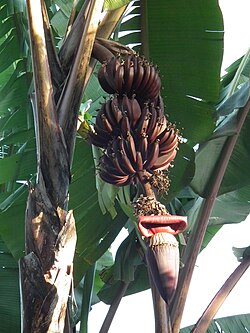This article needs additional citations for verification .(October 2024) |
| Musa acuminata 'Red Dacca' | |
|---|---|
 Red banana plant from Tanzania showing fruits and inflorescence | |
| Species | Musa acuminata |
| Cultivar group | AAA Group |
| Cultivar | 'Red Dacca' |
| Origin | South Asia, South East Asia |


Red bananas are a group of varieties of bananas with reddish-purple skin. Some are smaller and plumper than the common Cavendish banana, others much larger. Ripe, raw red bananas have a flesh that is creamy to light pink. They are also softer and sweeter than the yellow Cavendish varieties, some with a slight tangy raspberry flavor and others with an earthy one. Many red bananas are exported by producers in East Africa, Asia, South America, and the United Arab Emirates. They are a favorite in Central America, [1] [2] but are sold throughout the world.


